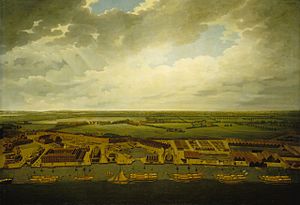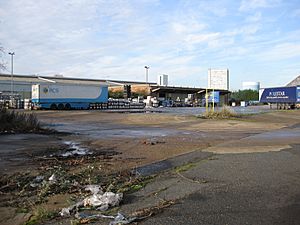Convoys Wharf facts for kids
Convoys Wharf is a historic site in Deptford, London, England. It sits by the River Thames. This place was once known as the King's Yard. It was the very first of the Royal Dockyards.
King Henry VIII started the dockyard in 1513. He wanted a place to build ships for the Royal Navy. Convoys Wharf also includes much of the land where Sayes Court manor house and gardens once stood. This was the home of John Evelyn, a famous diarist.
Until 2008, News International owned the site. They used it to bring in paper from Finland. Now, Hutchison Whampoa Limited owns it. There are plans to build homes here. However, a big part of the site is a "safeguarded wharf." This means it must stay open for ships and river trade.
Contents
History of Convoys Wharf
The First Royal Dockyard
The King's Yard began in 1513. King Henry VIII created it to build ships for the Royal Navy. It was the most important dockyard for a long time. The dockyard brought many people and wealth to Deptford.
Many famous people and events are linked to these docks:
- Sir Francis Drake was knighted by Queen Elizabeth I on his ship, the Golden Hind, right here.
- Captain James Cook started his third big voyage from here on HMS Resolution.
- Explorers like Martin Frobisher and George Vancouver also began their journeys from Deptford.
- Ships were sent from here to fight the Spanish Armada.
- Even Horatio Nelson's ships were connected to this dockyard.
In 1698, Tsar Peter I of Russia visited Deptford. He was 25 years old and wanted to learn about shipbuilding. He stayed at John Evelyn's home, Sayes Court, which was next to the dockyard. During his three months there, he and his friends caused a lot of damage to the famous gardens and the house. A statue now stands nearby to remember Peter's visit.
Changes and Closure in the 1800s
By the 1700s, the River Thames became too shallow. This meant large ships could not easily reach the dockyard. So, Deptford Dockyard was mostly used for building smaller ships and sending supplies to other naval bases.
The dockyard closed down from 1830 to 1844. In 1864, a group in Parliament suggested closing the Deptford dockyard for good. This idea was accepted. The dockyard officially closed in May 1869. About 800 people worked there at the time. It had built around 450 ships. The last ship built was HMS Druid, launched in 1869.
The Foreign Cattle Market
Before refrigerators, animals had to be brought into the country alive. In 1869, a new law said that the City of London Corporation had to create a market for foreign animals. They bought the Deptford dockyard site for this purpose.
The market opened in 1871. By 1889, it had grown to 27 acres. At its busiest in 1907, over 184,000 cattle and 49,000 sheep came through the market. But by 1912, these numbers had dropped a lot.
Convoys Wharf During the Wars
In 1914, during World War I, the War Department took over the Foreign Cattle Market. They used it as a supply base for the Royal Army Service Corps. After the war, many people wanted the market to reopen. However, in 1924, the War Office bought the site. They paid £400,500 for it, including the nearby Sayes Court land.
The Royal Naval Victualling Depot also operated here. This included a store for rum. During World War II, a bomb hit one of the storehouses. It was a sad event, and a plaque once remembered those who died. Because of the Blitz, some supplies were moved to safer places. The yard also served as a base for US amphibious vehicles during the war.
Later Years and Archaeology
The Victualling Depot closed in the 1960s. It was renamed the Royal Naval Stores Depot. It became the main air freight hub for the Royal Navy. It was very busy during the Falklands War. The depot also handled stationery and baggage for the armed forces. It finally closed in 1981.
News International bought the site from the UK Ministry of Defence in the 1980s. In 1993, the site's local government area changed. It moved from the Royal Borough of Greenwich to the London Borough of Lewisham.
Most of the old buildings from the 1500s to the 1800s were destroyed after 1955. But one building, the Olympia Warehouse, built in the 1840s, still stands. It is made of cast-iron and is quite special.
Archaeological studies have shown that most of the old dockyard structures are still there. They are just buried underground. These include the docks, slips, and basins. They are hidden by dirt and new ground. The Sayes Court garden area has not been fully explored yet.
In October 2013, Deptford Dockyard and Sayes Court garden were added to the World Monuments Fund's watch list. This means they are important historical sites that need protection.
Sayes Court
The War Department rented the Sayes Court area in 1914. They paid £90 a year to use it as a Horse Transport Reserve Depot. This helped them make their main supply depot bigger.
Later, the War Department bought the Sayes Court property and the Foreign Cattle Market. They paid £400,500 for both in the 1920s. This purchase included the railway, tramway, and wharf rights.
Dockyard Railways
From 1900, there was a tramway that connected to the Foreign Cattle Market. It used its own petrol locomotive. When the docks became an army depot, the railway was changed to a standard gauge. This allowed it to connect directly to the main railway line.
There was also a smaller, narrow-gauge tramway system inside the depot. The War Department started using steam locomotives on these tramways. Between 1915 and 1917, they bought twelve oil-fired locomotives. These engines ran on an 18 in (457 mm) gauge track. In 1920, the government announced they would sell the railway equipment. Some of these locomotives were sold to other railways. By 1938, most of the remaining engines at Deptford were no longer in use.



